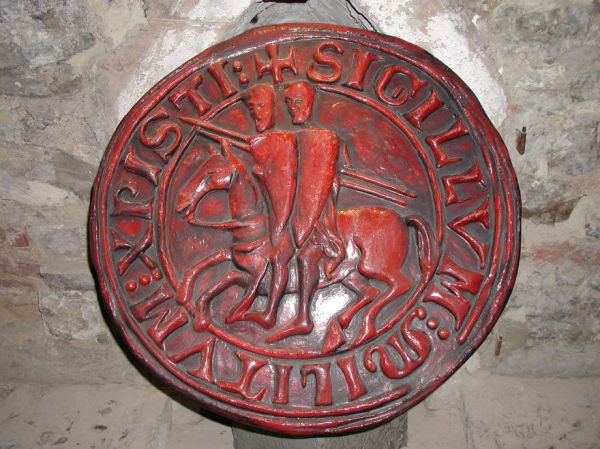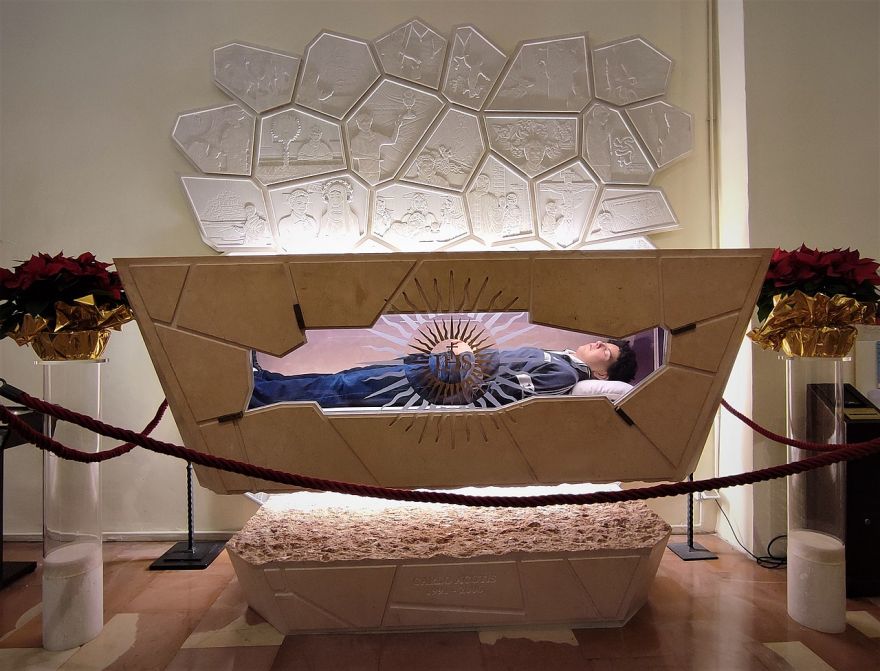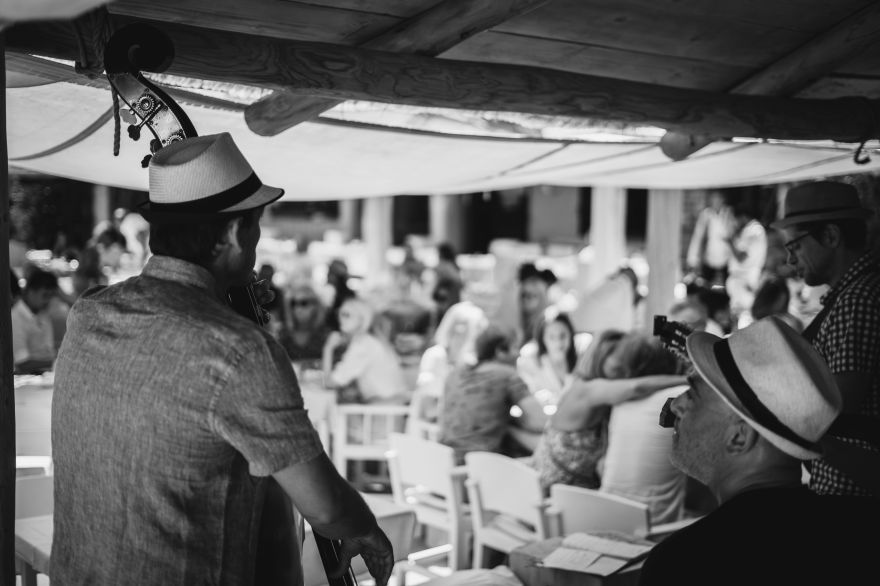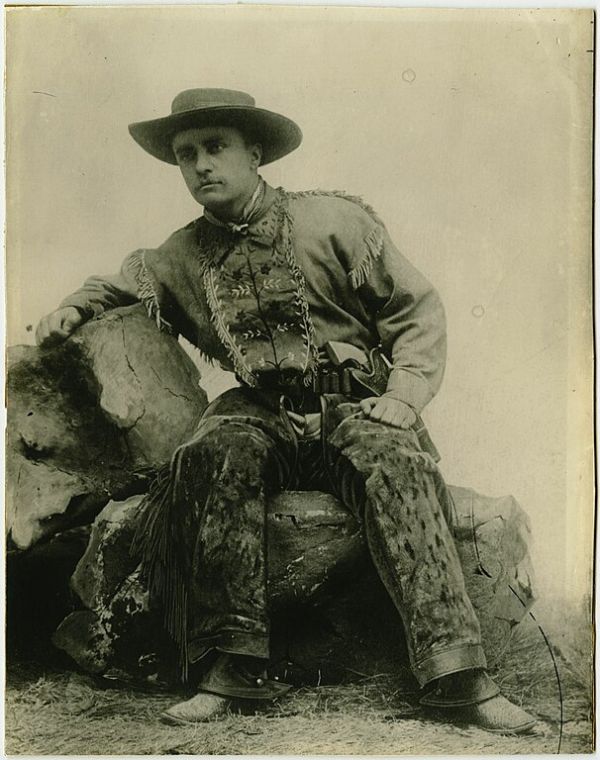Leonard Solomon has made a career out of building and performing on his own musical instruments. We've featured videos of his bottle organ and his oomphalapompatronium in previous video. In this video, he demonstrates that 21st century music, too, can easily be played on his weird instruments. Listen as he recreates Skrillex's 2010 song "Scary Monsters and Nice Sprites" on his instrument called a squijeeblion. It produces sounds that range from a nice melody to a foghorn fart to a crying beagle, and you better believe the bass drop is there, too. EDM will never be the same, although you can't really call it that, since this song was played with no MIDI involved. Also, the squijeeblion is powered by air, with both breath and bellows. Too bad you can't go down to the music shop and pick up your own squijeeblion. -via Metafilter, you'll find lots more of Solomon's music linked.

The Knights Templar was an order of wealthy and pious warriors who fought in the crusades. The order existed for 200 years, and their legend lives on in documentation and in imagery. One of the most mysterious examples of that imagery is the Templar seal, used to stamp and identify correspondence sealed with wax. The stamp, pictured above, shows two knights sharing one horse. What is the significance of this symbol?
The symbol has been interpreted in many ways. It could signify the Templar's vow of poverty, portraying knights having to share a steed. Or it could mean brotherhood, as in carrying each other. Or it could be a symbolic representation Christ being with them. Or it could be a subtle indication of homosexuality. Or possibly a combination of any of these, or something that no one has considered before. To really know, you'd have to ask a Knight of the Templar order, and they've been gone for more than 800 years. Read about the seal of the Knights Templar and how it has been interpreted at the Conversation.
(Image credit: Hinterkappelen)
Luna Lee is a Korean musician who specializes in traditional Korean instrument. She's a world-acclaimed master of the gayageum, a stringed instrument somewhat similar to a large European zither. In the past, we've featured her version of Chicago's "25 or 6 to 4" and AC/DC's "Thunderstruck."
Yesterday's Memorial Day commemorations may put my fellow Americans in a patriotic mood, so it is appropriate that Lee recorded our majestic national anthem.
In this video, Big Think invited Alan Alda to speak about some concepts related to good communication, particularly the use of jargon and hifalutin' words, which are highly technical or specialized terms that people in certain professions use, but which ordinary people like us may not regularly encounter in our daily lives.
Alda argues that jargon is useful because it is able to transmit meaning and information in an efficient manner especially between people who understand what those terms mean. However, its usefulness becomes moot once one incorporates the words into a context outside of their technical background or when they are being used to communicate with people who do not often encounter them.
Take, for example, the situation given by Alda in the video. Two doctors are presenting their diagnosis of a patient's conditon, an incurable cancer, and as the lead doctor continues to expound on their findings, the woman just sat listening to these long-winded explanations with a blank expression on her face.
After the lead doctor had finished, the medical student with him asked to stay behind and proceeded to communicate in simple, relatable, and comprehensible terms what the previous doctor had just said. And it was during that moment when the woman finally understood what her condition was, and she responded with tears running down her face.
Words are useful insofar as they are able to convey the message intended by a sender to the recipient, or by the speaker to the audience. If we simply use smart-sounding words to appear smart ourselves without thinking about whether the listener will understand what we mean by what we said, then that's not good communication.
Alda asserts that when we make a connection with the person to whom we are speaking, and they understood what we meant, that's when we are able to communicate properly. The mirroring exercise that the medical student and the woman did, i.e. as the woman cried because she understood what her reality was at that point, so the medical student also cried because there was a profound sense of connection that happened through their conversation.
We often experience a temptation to sound smarter by using hifalutin' words in our speech, but it would be pointless. I have heard this concept at least twice which says that truly smart people are those who can make complex ideas simple to understand by those with whom they are shared.
To demonstrate one's understanding of complex ideas and concepts, it is a matter of practicality that one should be able to explain those complex things to even a five-year-old, and help them understand what it means. Because then, you know for certain that you have a good grasp of the essence of those ideas and concepts.
So yes, just as Alda mentions in the video, it's fun to use jargon but only when the other person is able to catch the meaning as well. Otherwise, there is no point in having a conversation using those words. It would be much better to stick with simpler words and terms, so that you can focus on progressing the conversation with your counterpart and come at a more productive or fruitful outcome.
And in that sense, there's really a great need for empathy in order for us to have good communication with the goal of making our partner or counterpart understand what we're saying, whether it be a point of view, a factual summary, or an explanation of a concept, event, or something else. In so doing, we can arrive at conclusions, paradigm shifts, and possible solutions for whatever it is we're talking about without much misunderstanding in between.
(Video credit: Big Think)

A 15-year-old boy is now slated to become the Roman Catholic Church's first millennial saint. His name was Carlo Acutis, and he died in 2006 from leukemia. Sixteen years later, Pope Francis has approved a second posthumous miracle which the Medical Council of the Congregation for Saints' Causes had investigated and confirmed the validity of said miracles.
Acutis was born in London, and according to accounts from his mother, he would regularly engage in charitable acts toward the marginalized and disadvantaged in society, such as donating his pocket money to poor people, standing up for his disabled peers being bullied, and giving vagrants in Milan sleeping bags and meals.
At a young age, he taught himself how to code and he created a website that documents miracles around the world in an effort to help Catholic organizations.
The path to becoming a canonized saint for the Roman Catholic Church requires that the deceased person be involved in at least two verifiable miraculous accounts. According to the Vatican, once these two miracles attributed to the person in question has been verified, then they become candidates for sainthood.
The first of the two miracles attributed to Acutis was the recovery of a Brazilian boy from a rare pancreatic disorder after having been in contact with one of Acutis' t-shirts, at the same time, a priest had prayed to Acutis for the healing of the child.
And recently, in 2022, a Costa Rican woman claimed that she had been healed after a bicycle accident when her mother went to Acutis' tomb to pray for her. Valeria Valverde had undergone brain surgery but was still in critical condition. At that point, her mother went to Acutis' tomb to pray for her daughter, and immediately afterward, it is said that Valeria began to breathe without a ventilator and slowly recovered.
According to reports, Valeria was discharged 10 days after the miracle, with scans showing that the contusions on her brain had disappeared. - via The Daily Grail
(Image credit: Dobroš/Wikimedia Commons)

I don't know about you, but whenever I went out to eat at this ramen restaurant with a friend before, I always found it soothing to have some blues-y music or a chill playlist in the background while I chow on some spicy seafood noodles, and it actually helps me enjoy the food more, along with some casual conversation with my friend. Whenever it was some type of upbeat, pop music, I get fired up and focus more on eating the food.
There is something about the way music affects us and our behavior especially while we're eating. Ever wondered why high-end restaurants sometimes have classical or jazz music playing in the background? Apart from setting the atmosphere of the restaurant and giving off an elegant mood, it enhances our gastronomic experience.
Some research even suggests that the louder a restaurant's music plays, the more motivated patrons are to order unhealthy foods, likely due to the increased stimulation and stress brought about by the sounds.
There was also an experimental culinary experience conducted by the Italian Futurist movement in the 1930s, in which they would let their customers play musical instruments while eating their food. It sounds disconcerting, but the idea is that the combination of music and cuisine heightens the experience people have of both.
Whether or not customers find it pleasurable depends on who you're asking, but this is to say that there is precedent for the intermingling of auditory and gustatory senses.
In more recent times, the concept of "sonic seasoning" has floated about, suggesting that there may be a direct link between sound and taste. This link may be associated with synesthesia, or the perceptual phenomenon wherein our brains allow us to experience multiple unrelated senses, or said in another way, we're able to experience one sense through the lens of another.
Such is the field of sonic seasoning, in which the sounds that we hear can be described through taste. Some synesthetes say that listening to the piano is akin to eating caramel or chocolate, meanwhile, synthesizer sounds feel like eating black licorice.
The pasta company Barilla created "Pasta Playlists" on Spotify with which they recommend people eat their pasta, and in 2024, they commissioned the Al Bronzo Soundtrack Experience from White Lotus' composer Cristobal Tapia de Veer. For example, you may listen to the sounds of twinkling bells and vocal accents while taking a bite out of their rigatoni. Or, that rolling bassline as you savor their bucatini.
Whether it be a nice meal or a cup of coffee, I think most of us would not mind having some music playing in the background. Depending on the mood and context, it may impact our culinary experience in more ways than one.
Perhaps, the more intriguing part of this concept is the fact that you can hone in on particular sounds with which our brains would associate to further enhance the way we enjoy our food. But then again, who's to say that bells can make tomatoes taste sweeter, or rock music can make us crave for stuff like fries and burgers?
At the end of the day, some argue that music and food are highly subjective, so it would be difficult to concretize these connections and say that they produce the kind of effect they are purported to do. It's an interesting idea to explore, and see if there's any way to induce certain culinary experiences through music. But for now, we'll just have to wait and see.
(Image credit: Valentin Kremer/Unsplash)

Let me preface this by saying that, no, this has no political connotation, it has no relation to Brexit or anything of the sort, and it isn't remotely suggesting that Ireland finally wants to secede from the United Kingdom. It's far less serious than that, depending on which perspective you're going to take.
Have you ever been at a party and as the night wiles away, you find yourself getting the urge to leave but cannot find the right moment to say goodbye to the host or to other guests? So, you end up simply slipping away without anyone noticing? Well, it's not exactly "ghosting" per se, but this act has become known as "the Irish exit".
Conventional social etiquette and perhaps, at times, even our own consciences would dictate that, at the very least, we should let the host know that we'll be taking our leave, but some would argue that depending on the situation, it might be even more polite to simply leave without saying goodbye.
For instance, if you were in a large informal gathering of people, without an RSVP, then it might be excusable. Or, if the host is entertaining several guests and it would be considered even rude to interrupt them as you take your leave, then it would be acceptable to simply skedaddle without a hoot. However, such would probably not be the case when it's a more intimate gathering, or when the host themselves personally invites you to the party, and they welcome and see their guests out as they come and go.
The Irish exit seems to be peculiar however, as we generally have this image of Irish people being very jovial, warm, and hospitable, so to think that such a cold or rude act may be associated with them appears to be a misnomer or misleading. In fact, the term never originated from Ireland, but according to Irish author Judith McLoughlin, it's purely an American term.
There are a few theories as to the origin of the phrase, and some associate it with the 19th century Irish Potato Famine, which forced a lot of Irish people to depart from Ireland, perhaps never being able to see their loved ones again. And the sadness that came from that time in history may explain the use of the term, as for any host to simply not notice one of their guests leaving without saying goodbye, could be quite saddening indeed.
Another theory is that it was taken from the idea of hard-partying Irish Americans who needed to avoid the embarrassment at a party after they have consumed too much alcohol and become completely inebriated to the point that they have lost a grip on themselves. It can be seen as a face-saving gesture in this sense.
Whatever the origin of the term really is, it is used to describe that act of slipping away from a party or social gathering without saying goodbye. It's not a universal term, but several countries have a similar concept, which they call differently. For example, in Great Britain, they use the phrase "the French exit" or "the French leave" to mean the same thing. In turn, when you're in France, Russia, or Poland, they would say "leaving the English way". While in Germany, they would use "the Polish exit".
(Image credit: MAIRA ALI/Pixabay)
One of the funnier lines in the 1974 movie Young Frankenstein was when Igor (Marty Feldman) told Dr. Frankenstein (Gene Wilder) to "Walk this way." He didn't mean the direction, he meant the style. "No, walk THIS way!" A few months later, the song "Walk This Way" by Aerosmith was a hit. My friends and I would dance to it, and walk like Igor during the chorus. Yeah, it was funny. It turns out the song was actually named after that line in that movie! The music came first, then guitarist Brad Whitford saw Young Frankenstein and found the line so funny he insisted on using it for the song. Steven Tyler wrote the rest of the lyrics around the phrase. If that's not wild enough, wait until you find out exactly who inspired the song "Dude Looks Like a Lady."
Mental Floss takes a deep dive into the origins and meanings of 25 hit songs that you never really thought about, many of which changed considerably between the inspiration and the finished product. You can also listen to the list in the form of a video at the same link.

Theodore Roosevelt was America's 26th president, after raising cattle in North Dakota, fighting in the Spanish-American War, and serving as governor of New York, among other adventures. Many legendary but true tales are told about Teddy, including the one in which the Teddy bear was named for him. But there are always more. I have written about Roosevelt several times, and one even I hadn't heard of happened sometime around 1884.
Roosevelt entered a bar in Montana and saw that one guy was so drunk he had already shot the clock on the wall three times. Holding two guns, he mocked Roosevelt for wearing glasses and ordered him to fix drinks. Roosevelt managed to convince the drunk fellow that he was no danger, then punched him good, knocking the guy unconscious to the cheers of everyone in the saloon. The drunk left town and never came back. When Roosevelt told the story in his autobiography, he included a lot more details. You can read that one and five other true stories that show just how fearless Roosevelt was, at Cracked.
Drug lord Gustavo Fring (played by Giancarlo Esposito) made quite an impression as the toughest of tough guys on Breaking Bad. He managed to bluff his way through and survive many attempts on his life during the series with style and menace, so (spoiler coming) when he was eventually assassinated by a nonverbal colleague in a wheelchair, we were doubly shocked. What kept him alive through so much mayhem? Plot armor, produced by the character's popularity. By the time Fring actually died, we were all convinced he would be around forever. YouTuber Alternative Cuts (previously at Neatorama) spent two months editing together a video illustration of how bulletproof Fring really was. He confidently steps into danger, brought by all the badasses from Breaking Bad, then by other movie characters who shoot to kill. The walk gets longer and longer as every cinematic killer, no matter how ridiculous, is thrown at him. That's one tough character. -via Geeks Are Sexy

June 26, 1974 - This was the fateful day when the whole process of grocery shopping was revolutionized forever. It was on this day when Sharon Buchanan, an employee at Marsh Supermarket in Troy, rang up a seemingly insignificant pack of chewing gum for Clyde Dawson, Marsh's head of development and research.
The whole event seems to be utterly normal, mundane, and unamusing to many of us today, but that's only because the supermarket scanner has been a part of our daily lives, and for many of us, we don't remember a time when we went grocery shopping without it waiting for us at the counter.
If we had lived before that time, then not only did we have to wait for the cashier to ring up our groceries, but we even had to check whether the tally was accurate at the end of it all, since store clerks manually entered the price of each item on the cash register, instead of just swiping them on that red laser which automatically identifies the item and how much it costs.
But it was thanks to the invention of Norman Joseph Woodland and Bernard "Bob" Silver, who created the bar code system which enabled data to be stored in that rectangular label with lines of varying thickness and numbers written on top, that we are able to enjoy the speed and convenience of grocery shopping today.
Their invention was a remarkable step toward the ease of scanning grocery items. It wasn't until the National Cash Register Company and Spectra-Physics collaborated on developing the Spectra-Physics Model A, or the ancestor of the modern-day supermarket scanner, that the whole landscape of grocery shopping experienced a game-changing breakthrough.
With the new machines, it only took minutes to get through a whole bag of groceries as the device can easily detect loads of information and display them for verification, and it also reduced the number of mistakes that could have been committed with a manual system of input.
The original Spectra-Physics Model A currently sits at the National Museum of American History's electronic collection. Though it was a big, bulky steel-encased machine, much of the magic happened inside, out of sight from people who could care less what was going on. But that was the wonder of "frictionless" technology, something designed to be an "invisible" technology.
Today, we often take it for granted especially with the advent of the self-checkout register. But let's just take a moment to remember that on June 26th, 50 years ago, our lives would forever change.
(Image credit: National Museum of American History)

We no longer have the problem of 'being bored' these days because there's always so much that we can do. Smartphones, high-speed internet, and a smorgasbord of content online has afforded us all with so much to do that we often find ourselves not having enough time to actually consume all the media that we want to consume or do every task on our to-do list.
We are constantly on the go, always striving for a certain future goal, or always making sure that we spend every minute of every day efficiently in order for us to be as productive as we can be. And as a result, we're doing more over a shorter period of time, but at the same time, there are record levels of stress, anxiety, depression, burnout, and other mental health issues stemming from this evolved culture of productivity and the need to do more, and to get to our destination as quickly as we can.
Of course, there's nothing wrong with striving to achieve our goals. But, as Megan Feldman Bettencourt writes on Deseret, it appears that the casualties of this fast-paced mindset and lifestyle in the modern age have been rest, relaxation, hobbies, unstructured time, in-person social connection and even boredom itself.
Pushing ourselves and taking on challenges is a noble thing to do. It helps us discover the limits of our stamina, strength, abilities, and capabilities. But sometimes, we forget the other side of the coin which requires our bodies to recharge and replenish the energy that it spent. Overstimulation and the bombardment of information on our brains have us gasping for air to breathe, mentally and emotionally.
Honing in on boredom, Bettencourt asserts that boredom is just as important to children's development as all the other structured activities we plan for them. Just as much as we are engaged in the activities that we do in order for us to maximize the output and benefit we get from them, we also need to take time to disengage ourselves from the things that occupy us physically, mentally, and emotionally.
As an example, Albert Einstein often spent time away from friends, family, and work simply to do nothing but think. Boredom, or this act of being present in the moment, allows our minds to run free. It gives our imagination time to be creative and to resolve that itching feeling of "wanting to do something". It's that nagging deep inside us that will cause us to create "play" for ourselves.
This type of "play" is defined by child development experts as an activity a child chooses to do, rather than is obliged to do. It's basically those moments when we were kids and we created our own games from nothing, making our own rules, and enforcing those rules among the participants. It's those times when we as children built forts, told stories among ourselves which transported us to a world of fantasy built by our own imagination.
Nowadays, we merely consume what others have already built for us, and we wonder why we get so easily bogged down and stressed. We have no time to chill, although it is understandable that working adults find themselves in situations like these more often than not, but perhaps, this is the time that society experiences a paradigm shift. Workplace burnout has risen to alarming levels, with at least 55% of people saying they can't find work-life balance.
Perhaps this is the negative side effect of having technology and information at the tips of our fingers and in the palms of our hands. And perhaps culture has nudged us to such a point where it's horrendous to be doing nothing. But we need to recognize that human beings need time to flourish and to just be.
So, maybe as working adults, the best thing we can do is to simply find those moments of "just being, and doing nothing". To find rest for our minds, even as we simply space out while at work, or as we find ourselves sitting outside a cafe, looking into the horizon, and just wondering how wonderful life really is at that moment in time.
(Image credit: Katie Moum/Unsplash)

Apparently, he was listening to a Thracian slave girl playing the flute, and he was even lucid enough to critique the girl's lack of rhythm despite being in the throes of a fever. That's according to some newly deciphered passages from a papyrus scroll which had been buried after Mount Vesuvius' eruption in AD 79.
Plato is said to have died around 348 BC at the age of 80 or 81. He was said to have been buried within the Academy of Athens, the world's first university. The specific location was not known until new research about the papyrus has revealed that his burial site was in the garden of the Academy of Athens.
The team of Prof. Graziano Ranocchia, a senior researcher and Italian papyrologist at the University of Pisa, has recently uncovered these details with the use of the most advanced imaging diagnostic techniques which enabled them to reconstruct the layers of text within the papyrus which is stuck to each other.
Other information recovered from the papyrus included the fact that Plato was sold into slavery in the 4th century BC, either at the time when the Spartans invaded the island of Aegina or shortly after Socrates' passing in 399 BC. Before, it was believed that Plato had been sold into slavery in 387 BC, but once the team unfolded the papyrus and found sequences of hidden letters, the details of these events in Plato's life became clearer.
Currently, the technique that they are using is still in its early stages but it may prove very useful for other papyri that may have sequences in them which cannot easily be read without unfurling it, realigning the fragments of text, and virtually putting them back to their original positions, so as to restore the flow of thought and context of the passages.
Thankfully, the scroll had been preserved at the Villa of the Papyri in Herculaneum, which was discovered in 1750. Scholars have been attempting to decipher the scrolls for years, but due to the condition that the scrolls are in, only the most identifiable parts could be read and translated.
According to archaeologist Domenico Camardo, the impact of the Vesuvius eruption could be compared to the nuclear bomb dropped on Hiroshima during the second world war, because the heat of the pyroclastic surge led to the instantaneous death of many in Pompeii.
(Image credit: GeArtAp/Wikimedia Commons)

It has been 112 years since RMS Titanic sank several miles off the coast of Canada, and the photo above is said to have been taken two days after the event, and it apparently shows the iceberg that sank the ship. It was taken by the chief embalmer, John Snow Jr., who was on the Cable Ship Mackay-Bennett to help recover some of the bodies for burial.
Since more than 1,500 passengers died, the crew who were tasked to search for the bodies and collect them had to choose which ones will be taken back home and which ones will be laid to rest on the waters. They were able to recover 306 bodies, and they used the class system in the Titanic as reference to determine who needed to be brought back and who could be buried at sea.
The reason behind this was that passengers who had first-class tickets were more than likely to require the body to be identified so that their bereaved family may be paid from their life insurance. One such example would be Isidor Straus, the owner of Macy's department store, who was embalmed on the ship and placed in a coffin.
Second-class passengers were also embalmed and wrapped in a canvas, meanwhile, the 116 third-class passengers recovered by the crew had unfortunately been laid to rest at sea.
As for the photo, it has never been officially verified that it was the actual iceberg that sunk the Titanic, however, given the timing of the events, it is probable that the photo taken by John Snow Jr. aboard the Mackay-Bennett was the iceberg.
It went up for auction on April 27th, and originally, it was estimated to sell for £4,000 - 7,000 (around $5,000 - 8,700). Henry Aldridge auction house was able to sell it for £17,500 or about $22,000, as part of their Auction of Titanic, White Star and Transport Memorabilia sale.
Other items that went up for sale during the auction included John Jacob Astor IV's gold pocket watch engraved with his initials, and it sold for £1.175 million (around $1.4 million), as well as the violin case of the ship's bandleader Wallace Hartley which sold for £360,000 (around $450,000). Hartley's violin had already been sold in 2013 for £1.1 million (around $1.7 million).
(Image credit: Wikimedia Commons)

Remember that airline for dogs we shared with you last time? Well, BARK Air has finally got off the ground on Wednesday afternoon, carrying with it six dogs of varying breeds along with 11 humans, which included both passengers and crew, on a flight from New York to Los Angeles.
The idea was given birth with dogs in mind first, and their human companions second. For those who have taken their dogs along traveling, it might have been quite a hassle to figure out the best logistics to get your dog comfortable on the flight, since air travel was never designed to consider our pets as travel companions.
But with BARK Air, the primary focus of the experience are the dogs, and they intend to ensure a first-class experience for dogs in every step of the process from booking to arrival. Matt Meeker, the CEO and co-founder of the airline's parent, BARK, has shared that he had been working on the idea for over a decade.
Inspired by his late Great Dane Hugo, Meeker wanted to cater to other pet owners who wanted to bring their dogs along with them but have had to leave them in the cargo area as there would normally not be enough space for large dogs in the cabin. Furthermore, airlines have also become more strict with regard to emotional support animals, so BARK Air may just be a timely response to the current climate of air travel with pets.
Of course, because BARK Air does not own any planes themselves, they have partnered with Talon Air, which will provide the plane along with the crew and pilots, so it stands to reason that a one-way ticket will cost a hefty amount, specifically, $6,000 from New York to LA, and $8,000 from New York to London. This is inclusive of one human and one dog (or two dogs as long as they weigh under 50 lbs) and Meeker hopes that as the idea takes off, figuratively and literally, that these costs can be lowered over time.
It's basically a dog paradise in the air, as BARK is dedicated to pampering their passengers' pooches throughout the whole journey. Currently, the planes can accommodate as many as 18 human passengers, but BARK has limited that number to 10 to give way for more space for the dogs to play around. Human passengers are advised however, to keep their dogs on a leash, and out of courtesy, ask others for permission before approaching, so that order can be maintained on the flight.
Although it's a comfort for dog owners, there are concerns that dogs may misbehave despite all the precautions taken. However, on the most recent test flights that Meeker conducted, the dogs did not become unruly at all. Instead, they were all calm as a cucumber, which surprised the people on the experimental flights.
BARK has received an overwhelmingly positive response. They are getting tons of requests to add more destinations, like Chicago, on their schedule, which they have already published through the end of the year to accommodate people who buy their tickets in advance. At the moment, they have four round-trip cross-country flights a month, and they are thinking of opening a new route from New York to Paris in the fall.
(Image credit: BARK Air/Instagram)




